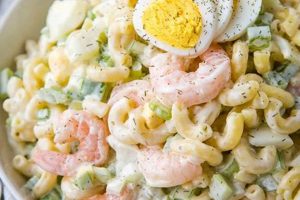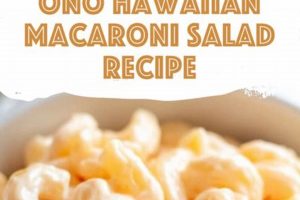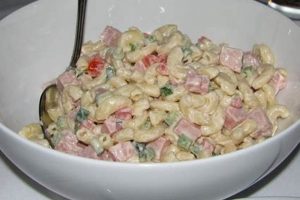A distinctly Pacific variation on the classic pasta salad, this dish typically features cooked elbow macaroni combined with mayonnaise. Key ingredients often include carrots, celery, and onions, creating a creamy, crunchy base. The “Hawaiian” designation usually signifies the addition of pineapple, which introduces a sweet and tangy element. Other regional variations may incorporate ingredients like tuna, hard-boiled eggs, or potatoes.
This type of pasta salad enjoys popularity due to its refreshing flavor profile, making it a well-suited side dish for warm climates and outdoor gatherings. The combination of creamy, crunchy, and sweet elements offers a pleasing textural and flavor contrast. Its relatively simple preparation and adaptable nature contribute to its widespread appeal, allowing for easy customization based on personal preferences and available ingredients. Historically, it has become a staple in Hawaiian cuisine, reflecting the islands’ diverse culinary influences.
The following sections will delve into specific ingredient selections, step-by-step preparation instructions, and suggestions for variations to personalize this dish. Further exploration will cover optimal storage techniques and serving recommendations.
Tips for a Superior Hawaiian Macaroni Salad
Optimizing ingredient selection and preparation techniques elevates this classic dish from satisfactory to exceptional. Attention to detail ensures a balanced flavor profile and desirable texture.
Tip 1: Macaroni Selection: Elbow macaroni is traditional, but other small pasta shapes work well. Slightly undercook the pasta to maintain a firm texture in the finished salad.
Tip 2: Pineapple Preparation: Fresh pineapple offers superior flavor. Canned pineapple can be substituted, but ensure it’s well-drained to prevent excess liquid in the salad.
Tip 3: Vegetable Enhancement: Finely diced carrots, celery, and onions provide essential crunch. Consider adding finely chopped bell peppers or water chestnuts for additional texture and flavor.
Tip 4: Mayonnaise Matters: High-quality mayonnaise contributes significantly to overall flavor. Experiment with different brands or consider making mayonnaise from scratch for optimal richness.
Tip 5: Seasoning Strategies: Salt and pepper are fundamental. A touch of celery seed or paprika can enhance the flavor profile. A small amount of apple cider vinegar or Dijon mustard adds complexity.
Tip 6: Chill Time: Allowing the salad to chill for at least two hours, or preferably overnight, allows the flavors to meld and the salad to achieve optimal consistency.
Tip 7: Garnish Considerations: Chopped green onions or toasted sesame seeds provide visual appeal and a subtle flavor boost. A sprinkle of paprika adds color.
By following these guidelines, one can achieve a well-balanced and flavorful Hawaiian macaroni salad. The careful selection and preparation of ingredients contributes significantly to a delightful culinary experience.
The following section concludes with a summary of best practices and serving suggestions.
1. Elbow Macaroni
Elbow macaroni’s significance within Hawaiian macaroni salad stems from its structural properties and cultural context. The curved, hollow shape of this pasta variety effectively captures the creamy mayonnaise dressing, ensuring each bite delivers a balanced flavor profile. Furthermore, its compact size allows for easy incorporation alongside other ingredients, contributing to the salad’s overall textural complexity. This practicality differentiates elbow macaroni from longer pasta shapes, which would prove unwieldy within the dish. Historically, the availability and affordability of elbow macaroni further solidified its place in local cuisine.
Consider the classic potluck gathering, a cornerstone of Hawaiian social life. Hawaiian macaroni salad, often featuring elbow macaroni, consistently appears as a staple dish. Its ability to be prepared in advance and served chilled makes it ideal for these occasions. The salad’s widespread popularity demonstrates the pasta’s effective role in creating a dish that balances flavor, texture, and practicality. Attempting to substitute elbow macaroni with longer or significantly smaller pasta shapes would disrupt this established balance. For instance, spaghetti would prove difficult to manage within the context of a salad, while orzo might become overly saturated with dressing.
Elbow macaroni’s contribution to Hawaiian macaroni salad extends beyond mere convenience. Its form and function are integral to the dish’s identity, ensuring both palatable enjoyment and cultural relevance. Understanding this connection provides valuable insight into the dish’s enduring popularity and the thoughtful consideration behind its seemingly simple composition. Selecting alternative pasta shapes would ultimately compromise the established equilibrium, impacting both the sensory experience and the dish’s cultural significance.
2. Mayonnaise base
The mayonnaise base serves as a foundational element in Hawaiian macaroni salad, contributing significantly to its characteristic texture, flavor, and overall appeal. Beyond simply binding the ingredients, the mayonnaise interacts with other components, influencing the final dish’s sensory experience and shelf life. Understanding its role is crucial for achieving the desired balance and consistency.
- Texture and Cohesion:
Mayonnaise provides the creamy texture that distinguishes Hawaiian macaroni salad from other pasta salad variations. Its emulsification properties allow it to coat the pasta and other ingredients evenly, creating a cohesive mixture. This coating also helps prevent the pasta from drying out, maintaining a desirable texture even after refrigeration. Insufficient mayonnaise can result in a dry, unappealing salad, while excessive mayonnaise can lead to an overly rich, heavy consistency.
- Flavor Delivery and Enhancement:
The inherent tanginess of mayonnaise complements the sweetness of the pineapple and the savory notes of other ingredients. It acts as a blank canvas for additional flavors, allowing for customization through the incorporation of spices, herbs, or other flavoring agents. The quality of the mayonnaise directly impacts the overall flavor profile; a bland mayonnaise will result in a less vibrant salad, whereas a high-quality mayonnaise can elevate the entire dish.
- Preservation and Food Safety:
The high fat content in mayonnaise contributes to the preservation of the salad. The coating it provides acts as a barrier, slowing down the oxidation process and preventing the ingredients from spoiling quickly. While this enhances shelf life, it’s crucial to observe proper refrigeration practices to maintain food safety. Improper storage can still lead to bacterial growth despite the preservative qualities of mayonnaise.
- Customization and Variation:
The mayonnaise base offers flexibility for customization. Different types of mayonnaise, such as those infused with herbs or spices, can introduce unique flavor profiles. Additionally, the mayonnaise can be thinned with milk or yogurt to create a lighter dressing, or thickened with additional ingredients to achieve a richer consistency. These variations allow for personalization and adaptation to individual preferences and dietary needs.
In summary, the mayonnaise base plays a multifaceted role in Hawaiian macaroni salad. Its influence extends beyond simply binding the ingredients; it shapes the texture, enhances flavor delivery, contributes to preservation, and allows for customization. Careful consideration of mayonnaise selection and its interaction with other ingredients is essential for crafting a well-balanced and satisfying Hawaiian macaroni salad experience.
3. Pineapple chunks
Pineapple chunks represent a defining characteristic of Hawaiian macaroni salad, distinguishing it from other macaroni salad variations. Their inclusion contributes a crucial layer of flavor and texture, directly impacting the dish’s overall sensory profile. This tropical fruit introduces a sweet and tangy element that balances the richness of the mayonnaise and the savory notes of other ingredients, resulting in a complex and refreshing flavor profile. The textural contrast provided by the firm, juicy pineapple chunks against the soft macaroni and creamy dressing further enhances the eating experience.
The historical context of pineapple in Hawaii underscores its significance in local cuisine. Pineapple cultivation has played a prominent role in the islands’ agricultural history, establishing the fruit as a readily available and culturally relevant ingredient. Its incorporation into traditional dishes like Hawaiian macaroni salad reflects this historical influence, solidifying pineapple’s position as a key component of local culinary identity. For instance, in local potlucks and family gatherings, the presence of pineapple in macaroni salad signifies a connection to Hawaiian culinary heritage. Omitting this key ingredient would alter the dish’s perceived authenticity.
The practical implications of using pineapple chunks in Hawaiian macaroni salad extend beyond flavor and cultural significance. The fruit’s natural acidity contributes to the preservation of the salad, inhibiting bacterial growth and extending its shelf life. Furthermore, canned pineapple offers a convenient and accessible option, particularly in regions where fresh pineapple may not be readily available. However, the choice between fresh and canned pineapple impacts the final dish; fresh pineapple typically offers a brighter, more pronounced flavor, while canned pineapple presents a softer texture and a sweeter, sometimes more subdued taste. Careful consideration of these factors allows for informed decisions regarding ingredient selection and preparation.
4. Complementary Vegetables
Complementary vegetables play a crucial role in Hawaiian macaroni salad, contributing texture, flavor, and visual appeal. These additions move beyond mere embellishment; they are integral to the dish’s overall balance and character. Careful selection and preparation of these vegetables enhance the sensory experience and contribute to the salad’s nutritional value.
- Textural Contrast:
The primary function of complementary vegetables lies in providing textural contrast to the soft macaroni and creamy mayonnaise. Commonly used vegetables such as carrots, celery, and onions offer a satisfying crunch, enhancing the overall mouthfeel. This contrast prevents the salad from becoming monotonous and adds a dimension of complexity. Diced bell peppers or finely chopped water chestnuts can further amplify this textural diversity, creating a more dynamic eating experience. The absence of these crunchy elements would result in a less satisfying, potentially bland texture.
- Flavor Enhancement:
Beyond textural contribution, complementary vegetables enhance the flavor profile. The subtle sweetness of carrots, the slight bitterness of celery, and the pungent bite of onions introduce nuanced flavors that complement the sweetness of pineapple and the richness of the mayonnaise. These additions create a more complex and balanced flavor profile, preventing the salad from becoming overly sweet or rich. Furthermore, the inclusion of vegetables like bell peppers introduces subtle vegetal notes that deepen the overall flavor composition.
- Visual Appeal:
The vibrant colors of complementary vegetables enhance the visual appeal of Hawaiian macaroni salad. The bright orange of carrots, the crisp green of celery, and the white of onions create a visually appealing dish that is more enticing to the palate. This visual element is particularly important in a dish characterized by a relatively uniform creamy base. The addition of colorful vegetables transforms the salad into a more visually stimulating and appetizing experience.
- Nutritional Value:
Incorporating complementary vegetables increases the nutritional value of Hawaiian macaroni salad. These additions provide essential vitamins, minerals, and dietary fiber, contributing to a more balanced and healthful dish. While often considered a side dish, the inclusion of nutrient-rich vegetables elevates the salad’s nutritional profile, aligning with contemporary dietary preferences for healthier meal options. This nutritional enhancement further distinguishes Hawaiian macaroni salad from other less healthful variations.
The careful selection and preparation of complementary vegetables significantly influence the overall quality and enjoyment of Hawaiian macaroni salad. Their contributions extend beyond simple additions; they are essential components that enhance the dish’s textural complexity, flavor profile, visual appeal, and nutritional value. Understanding the role of these vegetables allows for informed choices that elevate this classic dish from a simple side to a well-balanced and satisfying culinary experience.
5. Chilling Time
Chilling time is a critical element in a Hawaiian macaroni salad recipe, significantly influencing the final product’s flavor profile, texture, and overall quality. This period of refrigeration, typically a minimum of two hours but preferably overnight, allows for essential flavor development and ingredient cohesion, transforming individual components into a harmonious blend. This process, driven by temperature reduction and ingredient interaction, distinguishes a well-balanced and flavorful Hawaiian macaroni salad from a hastily assembled, less satisfying version.
The impact of chilling time manifests in several key ways. First, chilling allows the flavors of individual ingredients, such as the tangy mayonnaise, sweet pineapple, and savory vegetables, to meld and harmonize. This integration creates a more complex and balanced flavor profile compared to a freshly made salad where individual flavors remain distinct. Second, chilling firms the pasta, enhancing its textural integrity. This prevents the pasta from becoming mushy and ensures a pleasant chewiness. Third, the cold temperature solidifies the mayonnaise base, contributing to the salad’s overall cohesion and preventing it from becoming watery or separated. For example, a salad chilled overnight will exhibit a more pronounced pineapple flavor interwoven with the other ingredients, while a salad chilled for only a short period may taste predominantly of mayonnaise.
The practical significance of understanding the role of chilling time is substantial. Proper chilling not only enhances the sensory experience but also contributes to food safety. Lower temperatures inhibit bacterial growth, extending the salad’s shelf life and reducing the risk of foodborne illness. Furthermore, preparing the salad in advance and chilling it overnight offers convenience, particularly for large gatherings or potlucks. This allows hosts to focus on other preparations without compromising the quality of the macaroni salad. Failure to adhere to recommended chilling times can result in a suboptimal dish lacking the characteristic balanced flavors and desirable texture of authentic Hawaiian macaroni salad. Therefore, adequate chilling time represents a non-negotiable step in achieving the desired outcome and maximizing both enjoyment and food safety.
Frequently Asked Questions
This section addresses common inquiries regarding the preparation and enjoyment of this classic dish. Clarification on these points aims to ensure a successful culinary experience.
Question 1: What type of mayonnaise is recommended?
Standard mayonnaise works well, but using a high-quality mayonnaise or making one from scratch noticeably elevates the flavor profile. Experimentation with flavored mayonnaises, such as those infused with herbs or spices, can introduce unique nuances.
Question 2: Can alternative pasta shapes be used?
While elbow macaroni is traditional, other small pasta shapes, such as ditalini or shells, can be substituted. However, larger shapes may prove cumbersome, and significantly smaller shapes may absorb excessive dressing.
Question 3: How long can the salad be stored?
Properly refrigerated in an airtight container, the salad typically lasts for three to five days. However, the quality begins to degrade after the second day. Consuming it within 48 hours is generally recommended for optimal flavor and texture.
Question 4: Must the salad include pineapple?
Pineapple is a defining characteristic. Omitting it would fundamentally change the dish’s identity, resulting in a standard macaroni salad rather than a Hawaiian variation. However, adjusting the quantity of pineapple to suit personal preference remains an option.
Question 5: How can the sweetness be balanced?
If the salad is perceived as overly sweet, incorporating additional savory elements can restore balance. A touch of apple cider vinegar, Dijon mustard, or a pinch of celery seed can effectively offset the sweetness.
Question 6: What are suitable accompaniments?
This dish typically serves as a side. It pairs well with grilled meats, seafood, and other barbecue fare. It also complements sandwiches and lighter meals, offering a refreshing counterpoint.
Addressing these common inquiries clarifies potential ambiguities and promotes a deeper understanding of the dish’s components and preparation. This knowledge fosters successful recreations and personalized adaptations.
Further exploration might include regional variations, dietary adaptations, and advanced preparation techniques.
Hawaiian Macaroni Salad Recipe
Exploration of this dish reveals a nuanced interplay of ingredients, history, and cultural significance. More than a simple side dish, Hawaiian macaroni salad represents a culinary synthesis, blending accessible components into a harmonious whole. The creamy mayonnaise base, punctuated by the sweetness of pineapple and the crunch of complementary vegetables, offers a textural and flavorful experience unique to the islands. Chilling time emerges as a crucial element, allowing these distinct flavors to meld into a cohesive profile. Understanding the role of each ingredient, from the foundational elbow macaroni to the subtle seasoning choices, unlocks the potential for personalized adaptations while preserving the dish’s essential character.
This exploration encourages informed culinary practice, empowering individuals to recreate this classic dish with intention and appreciation. Further investigation into regional variations and innovative ingredient combinations promises continued evolution and enjoyment of Hawaiian macaroni salad, ensuring its enduring presence in culinary traditions.






